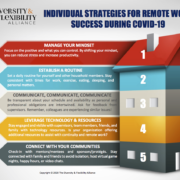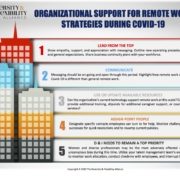Diversity & Flexibility Alliance Shares Best Practices for Organizations Transitioning to Remote Work During the Coronavirus Crisis
Washington, DC – March 16, 2020 – Given the growing number of organizations allowing employees to work remotely to reduce the spread of Coronvirus (COVID-19), the Diversity & Flexibility Alliance today released guidelines regarding telecommuting best practices to help ensure employees are safe, engaged and productive.
“We encourage all corporations and organizations to offer remote working to their employees, to the extent possible, during the Coronavirus crisis,” said Manar Morales, President & CEO of the Diversity & Flexibility Alliance. “However, it’s important that employers exercise patience as they implement remote working, in particular in organizations where telecommuting has not been the norm. Employers should be mindful of the unique challenges employees are facing during this unprecedented crisis, such as childcare during school closures, eldercare and a heightened level of anxiety and stress,” she added. “Employers should consider offering resources such as remote working training, as well as childcare and technology stipends to ease the economic and emotional tolls this crisis is taking.”
The following guidelines are relevant for both those organizations that already have a formal telecommuting policy, as well as those that don’t:
- Clearly Communicate Availability and/or Need to Telecommute. Organizations need to be crystal clear with their employees regarding telecommuting in the wake of COVID-19. For employees that need to telecommute due to possible exposure, organizations should reach out, clarify the need to telecommute and the length of time it is necessary, and offer resources to help with this arrangement. Additionally, many organizations are offering the option to telecommute to avoid exposure – again, it is important to communicate the length of time (if any) this option can be used and resources/support available.
- Best Practices for Telecommuters. It is not enough to simply inform employees that they can or must telecommute. It is important to provide employees with guidelines on ways to telecommute effectively. For example, employees need to communicate well with team members regarding deadlines, project updates and availability; communication is especially important in this situation as workers are more isolated and may have more personal conflicts than usual (i.e. children home from school). As another example, organizations should clarify the difference between working remotely and taking a sick day.
- Best Practices for Supervisors. It is equally important to provide supervisors with best practices and guidelines for managing remote workers and teams. Supervisors will need to remain patient and be mindful that employees are dealing with many unusual challenges at this time. Supervisors should clearly communicate expectations with those working remotely (i.e. specify when they should join meetings via phone vs. video), foster communication (i.e. virtual meetings/check-ins), and provide regular feedback.
- Communicate Support/Resources. Organizations should carefully think through available resources/support for telecommuting employees. This is particularly important now, when there may be employees who are not used to telecommuting regularly and a larger volume than usual who may be working remotely. Human Resources, Talent Development and D&I Professionals should convene and discuss available resources, including organization-wide support that can be leveraged from an Employee Assistance Program (EAP) and membership organizations.
- Consider Providing Additional Resources. As employees who need to telecommute now may face different challenges, organizations need to think through ways to help them. Work with your IT Department to understand what additional technology might be necessary. Does your organization have enough bandwidth to support a large volume of telecommuters? Does your organization have an application for virtual meetings? Do you want to consider providing technology allowances to make sure employees have the necessary resources to be as productive as possible? In addition, it is important to think through childcare/eldercare support. Some employees may face school closures and need childcare. Have you communicated any childcare resources and/or dependent care policy to employees? Have you considered providing a paid subscription for childcare/eldercare sourcing platforms (i.e. Care.com, Sittercity.com, UrbanSitter.com, etc.)? Would your organization provide a special childcare/eldercare allowance to help defray costs?
- Check-In to Understand Experiences. A member from the human resources or talent management team should check-in with employees to understand their telecommuting experience, including what’s working well and what needs to improve. This way, organizations can resolve any issues as quickly as possible, and gather success stories. For employees who are mandated to work remotely due to possible exposure to COVID-19, it is particularly important to check-in as they may already feel isolated.
The Diversity and Flexibility Alliance is a think tank that collaborates with organizations to develop non-stigmatized flexible work policies that promote inclusive work cultures and help to advance more women into leadership positions. The Alliance provides practical research-based solutions, training workshops, and strategic advisory services that increase organizational effectiveness through diversity and flexibility.
Contact: Manar Morales
manar@dfalliance.com
202-957-9650





